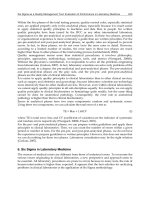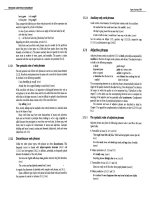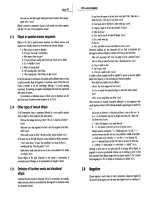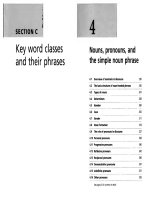Corrosion of Ceramic and Composite Materials Part 14 pdf
Bạn đang xem bản rút gọn của tài liệu. Xem và tải ngay bản đầy đủ của tài liệu tại đây (124.45 KB, 17 trang )
380 Chapter 9
vaporization of the water to extract heat from the refractory.
If the thermal gradient through the material becomes too steep,
failure may occur (this depends upon the thermal expansion
characteristics of the material).
Another method that has been used to lower the hot-face
temperature is to place metal plates either within individual
bricks or between them. A large portion of the heat is thus
conducted through the metal plate. A similar technique has
been used by manufacturing a product containing oriented
graphite particles. The steel industry has used many of these
techniques in their blast furnaces. The most common technique
today is the use of water-cooled internal metal plates (or boxes).
Another way to take advantage of increased cooling is
initially to use a thinner material. This will automatically cause
a thinner reaction layer to form on the surface. In general,
glass furnace basin wall linings should not be greater than 10–
12 in. thick. Anything greater than about 12 in. does not
normally increase overall life but adds an economic penalty in
refractory cost per campaign. The thickness at the flux-line
generally is 9 in. so that effective air cooling can be used. In
fact, most linings could probably be less than 10 in.; however,
the thermal-mechanical environment will determine the
ultimate thickness that should be used.
If a refractory lining is insulated, a greater portion of the
refractory will be at a higher temperature and corrosion will
proceed at a faster rate. In these cases, a balance must be
obtained between service life and energy conservation. Because
of the potential for increased corrosion of insulated linings,
the properties of the lining material must be carefully evaluated
before insulation is installed. In many cases, the engineer may
want to upgrade the lining material if it is to be insulated.
Historically, it has been recommended that flue gas
temperatures be 20–30°C higher than the dew point [9.4].
However, because of thermal efficiencies and the related cost,
this has been lowered to 5–10°C higher than the dew point.
Once condensation has occurred, reevaporation of the water
or other volatile can concentrate corrosive species causing a
Copyright © 2004 by Marcel Dekker, Inc.
Methods to Minimize Corrosion 381
more severe corrosion problem; thus condensates should be
removed as rapidly as possible.
The addition of redox couples in photoelectrochemical
corrosion of electronically conductive materials in acids acts
on the environment to minimize corrosion. An example is the
addition of cobalt as the redox couple to scavenge SO
4
-
that is
formed by the reaction of a positive hole with the sulfate ion
[9.5]. The positive hole is photogenerated in the valence band
of an illuminated titania semiconductor. The reactions listed
below act to minimize corrosion:
(9.2)
In the preservation of national monuments, engineers have tried
various materials to fill the porous limestones, marbles, etc. to
slow corrosion. Not only are the fillers used to eliminate open
porosity, but also they are used to consolidate or strengthen
friable portions of the structure. The most important parameter
of the fillers is that they too must be corrosion-resistant. Many
materials have been used to provide this filler/strengthening
characteristic from waxes to acrylic polymers to silicic ester-
type products [9.6]. According to Amoroso and Fassina [9.6],
these materials must have the following basic characteristics:
1. Control the diffusion of water
2. Protect against atmospheric pollutants
3. Possess a low coefficient of thermal expansion
4. Be inert toward the parent structure
5. Not modify the original appearance
Although the preservation of national monuments around the
world has been in progress for over 100 years, it has been only
recently that true advances have been made in their
preservation. At first, it would seem that the preservation of
monuments is not very much like the slowing or elimination
of corrosion of ceramics; however, the two areas are very much
Copyright © 2004 by Marcel Dekker, Inc.
(9. )
1
382 Chapter 9
alike. The major difference is that for the monuments, one is
concerned with their final appearance, whereas with ceramics,
in general, that is not the case.
9.3 CRYSTALLINE MATERIALS—NONOXIDES
9.3.1 Property Improvement
Most of the items discussed earlier can also be applied to these
materials. The one property improvement that should be
discussed a little further is that of porosity. For example, Si
3
N
4
is predominantly covalent and does not densify on heating as
do conventional ionic ceramics. In applications such as turbine
blades, a theoretically dense material is desired. Only through
special densification procedures can theoretically dense
materials be obtained. In the past, this could be accomplished
for Si
3
N
4
only through hot pressing with large amounts (up to
10 wt.%) of additives at very high temperatures and pressures.
SiC, in contrast, could be prepared in the fully dense state with
only a few percent of additives. Newer techniques have recently
been developed using gas pressure sintering and much lower
amounts of additives that allow the production of materials
that are fully dense. The additives in these processes cause a
liquid phase to form at high temperatures, and therefore
densification can proceed through liquid-phase sintering. This
liquid either crystallizes or forms a glass phase upon cooling.
Much work has been done in attempting to obtain either
crystalline phases with higher melting points or glassy
compositions with higher viscosities to improve the high-
temperature properties. The densification processes using lower
amounts of additives (generally <2 wt.%) help to maximize
the high-temperature properties.
Improved corrosion resistance of porous materials can be
obtained by impregnating with either a material of the same
composition as the bulk or with a material that, in the case of
SiC or Si
3
N
4
, is later exposed to a carbiding or nitriding
treatment. Other pore-filling materials can also be used, such
Copyright © 2004 by Marcel Dekker, Inc.
Methods to Minimize Corrosion 383
as nitrates or oxychlorides. Decomposition reactions then
produce pore-filling oxides. Impregnation with organosilicon
compounds will yield SiC as the pore filler.
Corrosion resistance can sometimes be improved by
changing the processing method. Chemical vapor deposition
(CVD) is one of the most attractive methods to produce high
purity dense materials because the sintering process is not
required if a bulk material can be obtained directly from the
raw vapors or gases. Microstructures of CVD products are
strongly dependent upon the deposition temperature and total
gas pressure. Chemical vapor deposition can produce
materials with no grain boundary phases but which are highly
oriented. It is a well-known fact that CVD materials contain
residual internal stresses. At present, the effects of these
stresses upon high-temperature strength and corrosion are
not well known.
Preoxidation under some conditions can form a protective
oxide layer that will minimize or possibly eliminate continued
corrosion [9.7]. In addition, impurities present, generally in
the form of sintering aids, may migrate toward the surface
and become part of the protective oxide layer. This layer can
then be removed resulting in a purer material with subsequent
improvement in mechanical properties.
The development of nitride-based materials today has
progressed to the point of studying materials in Si
a
M
b
O
c
N
d
systems, where M has been confined mostly to trivalent cations.
Most work has been in systems where M=Al, Y, and/or Be.
These materials form secondary grain boundary phases which
are highly oxidation-resistant and thus provide a better material
than conventional Si
3
N
4
materials.
Cemented carbide cutting tools made from WC wear rapidly
due to local welding of the tool to the steel piece being cut. To
overcome this welding, additions of TiC were made to the WC
to form a TiO
2
surface layer that protected the tool from rapid
wear. WO
3
also formed, but it was volatile and produced no
protective layer. In addition, small amounts of TaC and NbC
were added to increase the overall oxidation resistance by
Copyright © 2004 by Marcel Dekker, Inc.
384 Chapter 9
increasing the melting temperature of the carbide solution
formed.
9.3.2 External Methods of Improvement
One method of minimizing corrosion not widely practiced is
that of coating the ceramic with a layer of more resistant
material. Probably the best method to coat a ceramic is by a
layer of CVD [9.8] or plasma-sprayed material of the same
composition as the substrate [9.9]. Chemical vapor deposition,
in general, provides a better coating than plasma-sprayed
coatings since it is difficult to form pore-free coatings with
uniform thickness using plasma spraying. This provides a well-
attached, pure, nonporous layer that has a good thermal
expansion match with the substrate. Coating conditions can
be varied to produce layers of amorphous material covered by
crystalline material of the same composition. This sometimes
provides a more complex diffusion path that minimizes
oxidation.
Although plasma or flame spraying can be used to deposit
most materials, control of the spraying parameters confines
the coating to mainly oxides. Other methods investigated have
been cathode sputtering [9.8,9.10], glow-discharge cathode
sputtering, electron beam evaporation, and detonation
deposition. These methods are not necessarily confined to the
coating of nonoxides; oxides can also be coated.
Wittmer and Temuri [9.11] in their work on oxidation of
carbon-carbon composites have described a method of
protection by coating first with a well-adhering solid oxygen
barrier and then coating with a glass-forming material to seal
any cracks that may develop from thermal expansion mismatch.
The carbon-carbon composite coating system used for the Space
Shuttle nose cap is composed of an inner SiC layer covered by
a silicate glaze. This is probably the most successful example
of the use of oxygen barrier coatings to protect carbon-carbon
composites [9.12].
Copyright © 2004 by Marcel Dekker, Inc.
Methods to Minimize Corrosion 385
9.4 GLASSY MATERIALS
9.4.1 Property Optimization
The development of more resistant glasses has been predominantly
through optimization of compositions. Historically, small amounts
of alumina have been added to the basic soda-lime-silicate
composition to improve durability. In general, lowering the alkali
content increases the durability. This, however, has practical limits
based upon melting temperatures, viscosities, softening points,
and working ranges. Borosilicate glasses are, in general, more
are less resistant to alkali solutions than they are to acid solutions.
of varying compositions.
One technique of composition variation to improve durability
that has not received much attention is that of incorporation of
nitrogen into the glass structure. Frischat and Sebastian [9.13]
have shown that soda-lime-silica glasses containing 1.1 wt.%
nitrogen exhibited considerable improvement toward leaching
by water at 60°C over compositions containing no nitrogen.
This improvement was attributed to a denser structure for the
nitrogen-containing glass.
Small changes in the chemistry of the glass can cause a significant
change in the dissolution mechanism as shown by Lehman and
Greenhut [9.14]. They reported that 1 mol% P
2
O
5
addition to a
lead silicate glass caused the formation of lead phosphosilicate
crystals on the glass surface when exposed to 1% acetic acid at
22°C. They attributed the reduction in dissolution to the reduction
of the apparent average interdiffusion coefficient of lead by a factor
of 11.3. This is an example of changing the material chemistry to
form an interface reaction product that reduces the diffusion rate
of the species being leached.
9.4.2 External Methods of Improvement
The development of coating technology has provided a means
to improve corrosion resistance, abrasion resistance, and
Copyright © 2004 by Marcel Dekker, Inc.
resistant than soda-lime silicate glasses. In general, silicate glasses
Table 6.1 of Chap. 6 lists the corrosion resistance of many glasses
386 Chapter 9
strength. Combinations of coatings applied while the glass is
hot and after it has cooled have been developed that form a
permanent bond to the glass. These coatings are not removed
by cooking or washing.
The most commonly used metallic hot-end coatings are tin
and titanium. As the piece goes through the annealing lehr, the
metal oxidizes, forming a highly protective ceramic coating.
Tin is easier to work with since a thicker coating can be applied
before problems of iridescence occur. These hot-end metallic
coatings give the glass a high glass-to-glass sliding friction and
thus a cold-end coating must be applied over these metallic
coatings. The cold-end coatings usually have a polyethylene
or fatty acid base.
Another type of coating is one that reacts with the surface
of the glass to form a surface layer that is more corrosion-
resistant than the bulk composition. Chemically inert containers
are needed to contain various beverages and pharmaceuticals.
To provide increased corrosion resistance, these containers are
coated internally to tie up the leachable components. Internal
treatment with a fluoride gas provides a new surface that is
more corrosion-resistant than the original and is more
economical than the older sulfur treatment.
Although not a true coating technique, the manufacturers of
flat glass have, for many years, treated the surface of their
glass with SO
2
gas just prior to the glass being annealed to
increase the weatherability of their products. This surface
treatment allows the sodium in the surface layers to react with
the SO
2
forming sodium sulfate. The sulfate deposit that forms
on the surface due to this reaction is then washed off prior to
inspection and packing. The first step in weathering is then
diminished due to the low alkali content of the surface.
It has been shown by Harvey and Litke [9.15] that matrix
dissolution of an aluminosilicate glass apparently does not
occur if the leaching solution is saturated first with solution
products of the same glass composition. This technique is an
example of how dissolution can be minimized by decreasing
the driving force for corrosion by lowering the concentration
Copyright © 2004 by Marcel Dekker, Inc.
Methods to Minimize Corrosion 387
gradient between the material and leachant, thus minimizing
or eliminating the diffusion of cations and anions across the
interfacial boundary. Using a different approach to minimize
dissolution of a predominantly soda-borosilicate glass,
Buckwalter and Pederson [9.16] have shown that the sorption
of metal ions onto the glass surface and/or the buffering of the
leachate solution caused by the corrosion of metal containers
significantly lowered the rate of aqueous corrosion.
REFERENCES
9.1. McCauley, R.A. Evolution of flat glass furnace regenerators.
Glass Ind. 1978, 59 (10), 26–28, 34.
9.2. Brezny, R.; Semler, C.E. Oxidation and diffusion in selected
pitch-bonded magnesia refractories. J. Am. Ceram. Soc. 1984,
67 (7), 480–483.
9.3. Siljan, O J.; Rian, G.; Pettersen, D.T.; Solheim, A.; Schøning,
C. Refractories for molten aluminum contact Part I:
thermodynamics and kinetics. Refract. Appl. News 2002, 7
(6), 17–25.
9.4. Meadowcroft, D.B.; Cox, W.M. Dewpoint corrosion:
mechanisms and solutions. In Dewpoint Corrosion;
Holmes, D.R., Ed.; Ellis Horwood Ltd.: Chichester, UK,
1985. Chapter 2.
9.5. Harris, L.A.; Cross, D.R.; Gerstner, M.E. Corrosion
suppression on rutile anodes by high energy redox reactions.
J. Electrochem. Soc. 1977, 124 (6), 839–844.
9.6. Amoroso, G.G.; Fassina, V. Stone Decay and Conservation;
Elsevier: Amsterdam, 1983; 453 pp.
9.7. Lange, F.F.; Davis, B.I.; Metcalf, M.G. Strengthening of
polyphase Si
3
N
4
materials through oxidation. J. Mater. Sci.
1983, 18 (5), 1497–1505.
9.8. Davies, G.B.; Holmes, T.M.; Gregory, O.J. Hot corrosion
behavior of coated covalent ceramics. Adv. Ceram. Mater.
1988, 3 (6), 542–547.
9.9. Gogotsi, Yu.G.; Lavrenko, V.A. Corrosion protection and
development of corrosion-resistant ceramics. Corrosion of
Copyright © 2004 by Marcel Dekker, Inc.
388 Chapter 9
High-Performance Ceramics; Springer-Verlag: Berlin, 1992;
151–162. Chp. 7.
9.10. Gregory, O.J.; Richman, M.H. Thermal oxidation of sputter-
coated reaction-bonded silicon nitride. J. Am. Ceram. Soc.
1984, 67 (5), 335–340.
9.11. Wittmer, D.E.; Temuri, M.Z. Thermochemical studies in
selected metal-carbon-oxygen systems. J. Am. Ceram. Soc.
1991, 74 (5), 973–982.
9.12. Strife, J.R. Fundamentals of protective coating strategies
for carbon-carbon composites. In Damage and Oxidation
Protection in High Temperature Composites; Haritos,
G.K., Ochoa, O.O., Eds.; ASME: New York, 1991; Vol.
1, 121–127.
9.13. Frischat, G.H.; Sebastian, K. Leach resistance of nitrogen-
containing Na
2
O–CaO–SiO
2
glasses. J. Am. Ceram. Soc.
1985, 68 (11), C305-C307.
9.14. Lehman, R.L.; Greenhut, V.A. Surface crystal formation
during acid corrosion of phosphate-doped lead silicate glass.
J. Am. Ceram. Soc. 1982, 65 (9), 410–414.
9.15. Harvey, K.B.; Litke, C.D. Model for leaching behavior of
aluminosilicate glasses developed as matrices for
immobilizing high-level wastes. J. Am. Ceram. Soc. 1984,
67 (8), 553–556.
9.16. Buckwalter, C.Q.; Pederson, L.R. Inhibition of nuclear waste
glass leaching by chemisorption. J. Am. Ceram. Soc. 1982,
65 (9), 431–436.
Copyright © 2004 by Marcel Dekker, Inc.
389
Glossary
Cor·rode, v.t. to eat into or wear away gradually, as by
rusting or by the action of chemicals.
WEBSTER’S NEW WORLD
DICTIONARY
Alteration The change or modification of a material through
interaction with its environment, generally by the formation
of a new phase. This reaction need not be deleterious.
Atmospheric Corrosion The degradation of materials by
natural atmospheric environments. Atmospheric corrosion is
a term often used by the metallurgist, whereas an equivalent
term used by ceramists is weathering.
Copyright © 2004 by Marcel Dekker, Inc.
390 Glossary
Biodurability The ability of a ceramic to withstand the action
of a biological environment.
Condensation Corrosion Equivalent to dew point corrosion.
Corrosion The chemical interaction of a ceramic with its
environment, generally producing a deleterious effect. This
chemical reaction can, in some cases, be put to beneficial use.
Dealkalization The corrosion of a ceramic through the selective
solution of the alkalies into the corroding medium. Generally
used to describe the removal of alkalies from glasses.
Degradation A general decrease or lowering of the quality of a
ceramic; often through corrosive action.
Dewpoint Corrosion The deterioration of a solid ceramic
material caused by the condensation of a corrosive liquid from
a saturated gas when the temperature is lowered below the
point (the dew point) where the liquid will condense. A form
of atmospheric corrosion and equivalent to condensation
corrosion.
Dissolution Corrosion The corrosion of a ceramic through the
solution of its various components into the corroding medium
(generally a liquid).
Dissolution: Congruent, direct, or homogeneous When the total
ceramic chemistry dissolves simultaneously into the
environment.
Dissolution: Incongruent, Indirect, or Heterogeneous When
the ceramic dissolves in such a way as to leave behind a material
chemically different than the original ceramic as an interface
between the ceramic and the corroding medium. These terms
generally imply that the dissolution is selective.
Dissolution: Selective The corrosion of a ceramic through the
selective solution of one or more (but not all) species into the
corroding medium.
Dissolution: Anisotropic When the ceramic material dissolves
Copyright © 2004 by Marcel Dekker, Inc.
Glossary 391
at different rates parallel to different crystallographic or
geometric directions.
Dissolution: Isotropic When the ceramic material dissolves at
the same rate for all crystallographic or geometric directions.
Durability The ability of a ceramic to withstand the action of
its environment.
Electrochemical Corrosion The corrosion that takes place when
the reaction occurring involves electronic charge transfer.
Generally this type occurs when ceramics are in contact with
aqueous media, but may also occur in other media.
Galvanic Corrosion The corrosion that takes place when two
chemically dissimilar ceramics are in contact with one another,
both of which are in contact with the same electrolyte. Reaction
occurs only when current flows in an external circuit. A type
of electrochemical corrosion.
Hot corrosion Normally used to designate high temperature
oxidation of ceramics in contact with molten salt deposits.
This definition should probably not be used, since the term
Hot Corrosion is nonspecific and could apply to any type of
corrosion at an elevated temperature.
Intergranular or Grain Boundary Corrosion The corrosion
through any mechanism that takes place preferentially along
grain boundaries or between grains.
Leaching To remove through dissolution a portion of a ceramic
material.
Leaching: Selective Removes one species in preference to
another. The use of the word selective in this case is su-
perfluous.
Oxidation Embrittlement The embrittlement of a composite
caused by the oxidation of the interface between the
reinforcement material and the matrix resulting in a strong
bond between the two.
Copyright © 2004 by Marcel Dekker, Inc.
392 Glossary
Pesting The formation of a powder-like deposit on the exposed
surface of metallic silicides (i.e., MoSi
2
) during oxidation.
Photoelectrochemical Corrosion Electrochemical corrosion that
takes place when the charge transfer involves the positive holes
formed by photon illumination. Also called photo-dissolution.
Stress Corrosion Corrosion by any mechanism that is enhanced
by the presence of either a residual or applied stress.
Thermo-Oxidative Stability The resistance to oxidation at
elevated temperatures. Generally used in the discussion of
composite materials.
Weathering This term describes the atmospheric effects upon
materials of the construction industry, mostly structural clay
products, sandstone, limestone, marble, and glass; and is
essentially the attack by water vapor, CO
2
, and SO
2
.
Copyright © 2004 by Marcel Dekker, Inc.
393
Epilog
The literature and data available on the corrosion of ceramics
indicate that corrosion occurs by either one of several possible
mechanisms or a combination of these mechanisms. Many
similarities exist between the corrosion of crystalline and glassy
ceramics, although in general glass corrodes more rapidly under
identical environmental conditions.
Corrosion in either crystalline or glassy ceramics can occur
by a direct process where the ceramic congruently dissolves into
the corroding medium. Reaction rates are generally linear, being
proportional to the duration of the test. One way to minimize
this type is to saturate the corroding medium with the same
chemical species that are dissolving from the ceramic. Another
way to minimize this type of corrosion is to add something to
the ceramic that will diffuse to the surface and react with the
corroding medium forming a protective interface layer.
Copyright © 2004 by Marcel Dekker, Inc.
394 Epilog
In another type, apparently the more common type of
corrosion process, indirect, in either crystalline or glassy
ceramics, species from both the corroding medium and the
ceramic counterdiffuse and react at the interface forming a
glassy, a crystalline, or a gaseous interface reaction product. If
the interface reaction product is solid, continued corrosion can
occur only by continued diffusion through the interface. In
some cases, the interface reaction product may be multilayered.
The reaction layer thickness may vary from a few nanometers
to several hundred micrometers. Reaction rates are generally
parabolic, being proportional to the square root of time. One
way to minimize this type of corrosion is to prereact the ceramic
to form an initial interface reaction layer that, if protective,
will slow continued reaction. Another way is to add something
to the ceramic that will form a layer through which diffusion
will be more difficult.
In the first case discussed above, the corroding medium can
be either a liquid or a gas; however, in gaseous corrosion one
may not consider the dissolution to be congruent if the products
are two different gases, as in the active oxidation of SiC to SiO
and CO
2
. In the second case above, the medium can again be
either liquid or gaseous with either all or part of the ceramic
forming the layer. In most cases, only part of the ceramic forms
the layer (i.e., selective dissolution). In corrosion by liquids,
the mechanisms are different if the corroding medium is a glass/
slag versus water. In water, the first step is usually ion exchange,
whereas in glass/slag attack, the first step is counter-diffusion,
not quite the same as ion exchange, although ion exchange
may take place in glass/slag attack.
Multicomponent ceramics generally corrode by a mixed
mechanism with each step exhibiting a different and unique
reaction rate. In these cases, the overall reaction rate will exhibit
a mixed rate law, being neither linear nor parabolic.
Extended duration tests have indicated that the mechanism
of corrosion may change after some extended time. This is
especially true for oxide layers formed on nonoxide ceramics
during gaseous corrosion. This change in mechanism is due to
Copyright © 2004 by Marcel Dekker, Inc.
Epilog 395
one or more of the following changes: crystallization of
amorphous layers, alteration of crystalline phases as diffusion
continues, cracking due to crystallization and alteration, and
spalling. The few studies that have shown these changes indicate
that one must be careful in making life-time predictions based
upon data from short-time laboratory tests.
In all cases, an increase in temperature increases the rate
of corrosion. The mechanism of corrosion, however, may
change as temperature is increased due to crystallization of
amorphous reaction layers, polymorphic transitions, melting
of crystalline layers, vaporization of various species in the
layer, cracking, etc.
One method of minimizing corrosion that requires more
emphasis appears to be the various coating methods. These
could be used to advantage in composites where the initial
step is, for example, oxidation of SiC fibers. By coating the
fibers before incorporation into the matrix, oxidation may be
slowed or even eliminated. The object is to find a material
through which the diffusion of oxygen is a minimum and then
use this material to coat the fibers. The technique of electrostatic
attraction in an aqueous dispersion appears attractive as a
coating method for materials such as fibers.
Although the above discussion may be an oversimplification
of the corrosion processes that occur in ceramics, it is a step in
the direction of simplifying and unifying the whole area. All of
the data and discussion about corrosion point towards the
need for more in-depth diffusion and solubility studies of the
various species in the different corroding media encountered
in practice.
Corrosion, being an interfacial process, requires a thorough
understanding of the surface structure of the materials being
corroded. Thus the study of single crystals is the best method
to determine the fundamentals of corrosion mechanisms.
Although the crystal surface characteristics determine short-
term corrosion behavior, they may not be as important for
long-term corrosion. Single crystals do lend themselves to the
evaluation of the effects that various dopants have upon
Copyright © 2004 by Marcel Dekker, Inc.
396 Epilog
leaching kinetics. In addition, various types of defects (e.g.,
vacancies, dislocations, etc.) could be incorporated into the
lattice during production of the single crystals.
A large amount of published data on the corrosion of
crystalline and glassy ceramics points toward the fact that more
compact structures are more durable. In the study of glasses,
references are made to corrosion being a function of glass
structures, which are related to parameters such as composition,
the number of nonbridging oxygens, the amount of cross-
linking of the network structure, the degree of network packing,
the density, the strength of the bonding, and the amount of
covalent bonding. References have also been made to compact,
strongly bonded glass structures being those with low thermal
expansion and high softening points. Thus a technique that
would determine the structural tightness may be sufficient to
rank the durability of various materials, at least in the various
compositional classes and to a specific environment. In addition
to thermal expansion and softening point determinations, the
determination of hardness may also yield information related
to durability. Hardness is a measurement, however, that must
be performed with some care, since hardness varies with the
applied load and cracking and friction may interfere with the
measurements. There has been no systematic study reported
in the literature of the corrosion of ceramics related to
properties such as expansion, hardness, or softening point.
Only through a thorough understanding of all the
parameters involved can the engineer make an intelligent
selection of the material that will best resist corrosion for a
particular application. Only through intelligent materials
selection can the cost of corrosion be minimized. Since the
application of ceramics requires the optimization of properties
other than corrosion resistance, a compromise among corrosion
resistance, properties, and cost is generally needed.
Copyright © 2004 by Marcel Dekker, Inc.









